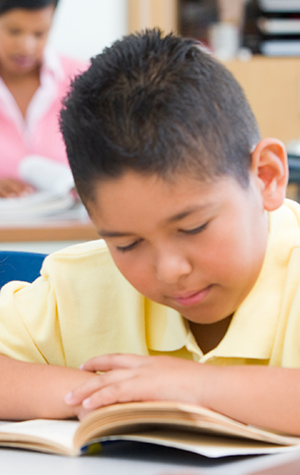Breakthroughs in the Making
Education research heralds big changes for the classroom

Attendees at Deaf Deaf World, an annual event about deaf life hosted by SED’s Deaf Studies Program. Photo by Kalman Zabarsky
Thanks to research in progress at BU, schools may soon have better deaf education, more girls and diverse youth preparing for math and science careers, and less anxious, better-performing students.
Leading reform in deaf education
Want to know how well a hearing child understands written English? There are standardized tests for that. But educators have virtually no tools to evaluate deaf children’s knowledge of American Sign Language (ASL), says Robert Hoffmeister. The American Sign Language Assessment Instrument (ASLAI) will change that.
This computer-based tool, which the associate professor of deaf studies is developing, covers topics like vocabulary and verb agreement, just like in English language tests. But ASLAI users answer by signing on camera or selecting a video clip in which the correct answer is signed. Hoffmeister hopes the ASLAI will reveal how language impacts thinking and learning in deaf children, and prove that they’re more intellectually capable than some have given them credit for.
Hoffmeister, who directs BU’s Center for the Study of Communication & the Deaf, has been working on the ASLAI since 1989. A four-year, $1,566,200 grant from the US Department of Education in 2010 provided a boost. Hoffmeister and a team of deaf and hearing graduate students are developing the tool and testing it with deaf students ages 4 to 18 in several states. Once completed in 2015, the ASLAI will help “identify developmental changes in ASL abilities as well as distinct profiles of learners who may be at risk for learning problems,” Hoffmeister says. He hopes this will inform and improve ASL instruction.
“A lot of research states that deaf children don’t ‘get’ language,” sparking interventions like cochlear implants and speech therapy, signs project member Jon Henner (’15). But their team has found that students’ skill levels in ASL and English literacy correspond. “The field tends to have a low expectation of what deaf children in schools can do,” says Hoffmeister, “and that’s really what we want to change.”
Exploring anxiety’s impact on children’s reading

Sweaty palms, a pounding heart, visions of failure. Studies have shown that anxiety, while a motivating factor if moderate, can hamper children’s problem-solving and decrease their performance on classroom tests. But what about children who aren’t just anxious at test time? Can their anxiety interfere with classroom activities like reading? And, in turn, can struggling to read cause anxiety? Amie Grills believes the answer to both questions is yes.
Grills, a licensed clinical psychologist and an assistant professor of counseling psychology & human development, is studying the little-explored relationship between anxiety and reading in children. With the help of a five-year grant for more than $600,000 from the Eunice Kennedy Shriver National Institute of Child Health and Human Development, Grills and colleagues at the University of Houston ran a study in Texas from 2008 to 2013 of more than 400 students in grades one through three. Having published results showing that anxiety can predict reading difficulties and vice versa, she’s now exploring how that connection works over time. For example, she says, “How likely is it that a kid who was struggling to read in kindergarten develops an anxiety disorder by third grade?”
She’s also asking this critical question: how do we fix the problem? Grills designed an anxiety-reducing intervention for struggling readers that she’s testing in a pilot study whose results will be available this summer. “My hope is that by reducing the stress and anxiety children feel about reading, we can improve reading outcomes as well as children’s overall learning experiences,” she says.
Sparking interest in STEM

Kimberly Howard has given middle-schoolers some complex assignments, from repairing a model bridge to building a solar cooker for a fictional African village. Her goal: to increase their interest in science, technology, engineering, and mathematics (STEM) careers.
Howard, associate professor of counseling psychology & human development, says studies show that children as young as four assess their career options based on ideas about gender and socioeconomic status. And although girls and diverse youth often identify socially oriented, altruistic career goals, they don’t tend to associate those goals with STEM careers, like engineering, in which they’re underrepresented. What would happen, Howard wondered, if she introduced a curriculum that exposed students to engineering careers and showed how they give back to society? Could this increase interest in STEM activities among underrepresented groups?
Howard launched a study with engineering colleagues at the University of Wisconsin and a $1,025,015 National Science Foundation grant. Howard’s co-investigators and their fellow engineers created Society’s Grand Challenges for Engineering, a story-based, hands-on curriculum that ties math and science knowledge to societal change (as in the solar cooker activity). From 2011 to 2013, middle-school math and science teachers in Wisconsin public schools used the curriculum for several weeks each year.
Howard, who expected to complete data analysis in 2014, says preliminary results show that at the end of the study, girls, African Americans, and low-income youth who used the curriculum showed more interest in STEM careers than their comparison group counterparts. The program also sparked a sense of play. “Kids would spontaneously come up to their teachers and say, ‘You know what? I love our math class because it doesn’t feel like we’re learning math; it feels like we’re having fun.’”